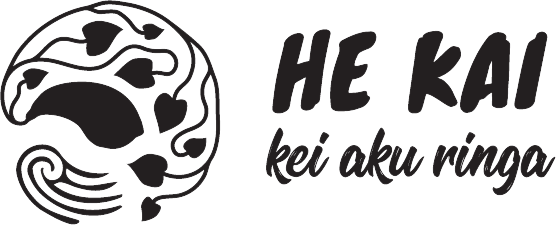07 Aug Rino (iron) Awareness Week 2020
What is iron and why do we need it?
Rino (iron) produces a molecule called haemoglobin which carries hāora (oxygen) around our tinana. It is also important for our immune function and hauora.
There are two types of rino; haeme and non-haeme. Every day you should include kai from all of the atua Māori to ensure consumption of both types of iron. Tāne for mīti, heihei (chicken), rēme (lamb) and mīti kau (beef). Tangaroa for kaimoana, Rongo for all our cultivated kai like kūmara, kōkihi (spinach) and Haumia for all our wild foods like pūha and kōwhitwhiti.
Haeme rino is a type of rino found in ngā kai a Tāne: mīti, heihei, and kai a Tangaroa ki tai; Ahiahi (tuna), haramono (salmon), rimurimu (seaweed), as well as Tangaroa ki uta; īnanga (whitebait), tuna (eel). This type of rino is easily absorbed by our bodies so we do not need to eat as much. Whilst kai from all of the Atua are important, some have higher sources of rino than others. Foods listed under Tāne and Tangaroa have the highest amount of easily accessible iron for our bodies. Therefore, mīti, heihei, rēme, mīti kau and kaimoana are all great sources of rino. Although ngā kai a Papatuānuku, such as huawhenua, and ngā kai a Haumia, wild foods of Haumia, aruhe (fern root), kōkihi (spinach), Ti Kouka (cabbage tree,) also contain rino.
Non-haeme rino is found in eggs and plant based foods such as legumes, wholegrain kai and cereals, nuts and seeds as well as green leafy huawhenua such as pūha. Vitamin C is a nutrient found in huarākau such as lemons, oranges, kiwifruit, carrots, and capsicum and these huawhenua will help our bodies to absorb more rino. It is important to have a variety of kai to get a variety of nutrients.
Tea and coffee are known as inhibitors for rino absorption and are best had after your meal.
Recommended intake
| Age | Rino recommended daily intake (mg) | |
| Wahine | 19-50
14-18 Over 50 Wahine Hapu |
18
15 8 27 |
| Tane | 19-70+
14-18 |
8
11 |
Physical ways to tell if you may be rino deficient:
- Looking pale
- Lightheadedness
- Feeling tired and/or struggling to concentrate
- Brittle nails
Low rino blood levels can be caused by:
- Not eating enough iron-rich kai
- An increased need for rino e.g. Hapu wahine, mate wahine
- Rino being lost in the gut through conditions such as peptic ulcers, tumours or ulcerative colitis.
If you are worried about your iron levels it is important to talk to a doctor and request a blood test. Iron supplements should only be taken under the advice of a doctor or health professional.
Kaimanga/ kaikararehe kore diets
Vegetarian/vegan diets are rich in non-haeme rino which is not as easily absorbed by our tinana. Therefore, you may need to eat more amounts of kai which are high in rino.
Top tips for avoiding kōpaka rino (Iron deficiency):
- Make sure you eat a variety of rino-containing kai throughout the day and at each meal time.
- Include a vitamin-C rich huarakau like kiwifruit, oranges, lemons or huawhenua like capsicum, carrot at each meal time as these will enhance the absorption of rino.
- As mentioned above, drinking tea and coffee at meal times inhibits iron absorption.
- Use the kai listed below
Some snack ideas include:
- Hummus and capsicum sticks
- Berries and kiwifruit in cereal
- Wholegrain crackers with tuna and/or tomatoes
- Lemon juice drizzled on salad
Rino in kaimanga/ kaikararehe kore diets:
| Source | Amount | Source | Amount | |
| Tofu (100g) | 5.4mg | Baked beans (1 cup) | 1.6mg | |
| Boiled spinach (1 cup) | 2.5mg | 1 Boiled egg | 0.9mg | |
| Cooked chickpeas (1 cup) | 1.6mg | Porridge (1 cup) | 1.3mg |
Tāne and Tangaroa sources of rino:
| Source | Amount | Source | Amount | |
| 1 grilled lean beef fillet steak (173g) | 5.8mg
|
90g can salmon | 2.1 mg | |
| ½ cup green mussels, marinated | 7.5mg
|
1 grilled chicken breast (107g) | 2 mg | |
| 2 grilled lean lamb leg steaks (116g) | 4 mg | 1 grilled lean pork loin chops (74g) | 1.2 mg | |
| 1 slice fried lamb liver
|
4 mg | 1 baked tarakihi fillet
|
0.8 mg |
https://nutritionfoundation.org.nz/nutrition-facts/minerals/iron
Iron Overload (Haemochromatosis)
What is Haemochromatosis?
Usually, we absorb only as much rino as we need from the kai we eat. However, those who suffer from haemochromatosis absorb more rino from their kai than their tinana needs. In the body, too much rino is toxic and may decrease your body’s immune system. Long term excess rino may permanently damage internal organs like your liver, heart and pancreas. This condition is more common than some may think, with one in 200 New Zealanders suffering from it. It occurs in tane 2-3 times more often than wahine and usually only becomes apparent around 40-50 years of age.
What are the symptoms?
Often Haemochromatosis sufferers display no symptoms until they are older and rino has accumulated. Common symptoms include:
- Tiredness
- Joint pain
- Abdominal pain
- Generally feeling under the weather
- Low libido
As the condition progresses, symptoms may become more severe. Such as liver issues, diabetes, cardiomyopathy, and a grey skin pigmentation.
All of these symptoms occur due to the iron accumulation in internal organs in the body. They occur progressively and sufferers may notice one or many of the symptoms. Often the disease is not diagnosed until routine blood tests show elevated blood iron levels.
Can I treat it with diet?
Haemochromatosis cannot be controlled by diet alone. However, eating a balanced diet (including a little red meat) can be beneficial. Avoiding things such as alcohol, vitamin C, iron supplements, and avoiding iron rich foods such as offal is often recommended.
Drinking tea with meals may also be encouraged as it can help reduce the amount of iron your body can absorb.
If you think you, or someone in your whanau is suffering from Haemochromatosis, see your healthcare professional to discuss your symptoms and to test for a diagnosis. Check with your healthcare provider (GP/dietitian) before making changes to your diet.
Nā Gypsy Billing-Bullen and Jade Curnow, Massey University Dietetic students
(Sande Mareroa-Gates, Toi Tangata Supervisor)


